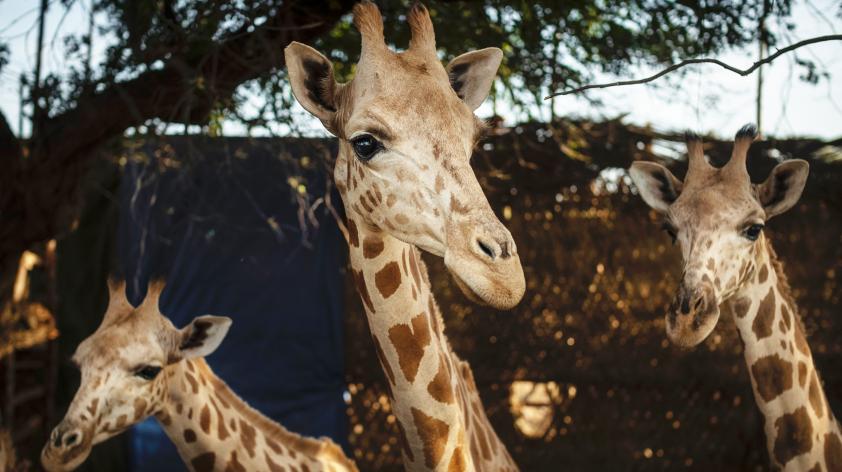
A Towering Conservation Success
Operation Sahel Giraffe
Eight West African giraffe travelled over 800 kilometers (500 miles), about the distance from San Diego to San Francisco in 48 hours to be safely re-introduced to the Gadabedji Biosphere Reserve in Niger, after an absence of almost 50 years. The operation was led by the Giraffe Conservation Foundation, the Sahara Conservation Fund, and the Niger Government, and it is the first ever such operation in Niger. San Diego Zoo Global supported the operation, and I was part of the field team.
In the late 1960s, giraffe became locally extinct in the Gadabedji area because of drought and illegal hunting, but the habitat still remained, silent and empty. About six years ago Niger’s Wildlife Authority, with support of partners, has worked diligently towards improving security, restoring the region’s wildlife and their habitat.
The world’s last remaining population of West African giraffe Giraffa camelopardalis peralta, a subspecies of the Northern giraffe Giraffa camelopardalis, is restricted to the "Giraffe Zone" in the Republic of Niger. The "Giraffe Zone" is not formally protected, rather it forms part of the W Transboundary Biosphere Reserve, covering more than 1,700km2.
In the mid-1990s there were only 49 West African giraffe left in the wild, and as a result the IUCN Red List categorized them as Endangered. This prompted comprehensive conservation efforts by the government of Niger, in collaboration with local and international partners, resulting in an amazing recovery of the West African giraffe population to over 600 individuals today.
However, despite the recovery, since this last remaining population of these giraffe is isolated, they still remain deeply imperilled to disease, drought, climate chaos and growing human presence.
Once widespread throughout West Africa, including Senegal, Mauritania, Mali and Nigeria, West African giraffe now only occur in Niger. In the "Giraffe Zone" this last population of West African giraffe share their habitat with local communities, overlapping for space and resources.
Despite the local communities support of giraffe conservation, one result of the recovering giraffe population and increasing human population pressure, giraffe have started to migrate out of the "Giraffe Zone". This movement finds the giraffe in conflict situations with human populations who are unaccustomed to their presence in Niger, and too close to the insecure border areas with Mali.
Bold action was required, and the planning to sustainably create a second population of West African giraffe in Gadabedji began in earnest; in November 2018, Operation Sahel Giraffe commenced.
Eight giraffe were individually captured in the "Giraffe Zone" and transferred to a holding pen (boma), where they were kept for more than three weeks to prepare them for the long journey. The eight giraffe were then transported in two groups of four, an arduous journey for both the giraffe and the team, much if it off-road across difficult frontier terrain.
However, the efforts paid off, where upon arrival, the giraffe were successfully release into Gadabedji Biosphere Reserve, returning to their home after 50 years.
The giraffe are constantly monitored by the Gadabedji team, to observe them and track how they are adjusting to the new environment. As of December 24, 2018, all the giraffe are doing well and are thriving so far, and exploring the reserve.
Should these pioneer giraffe continue to do well, more giraffe may be translocated there in future to bolster this new population. The re-introduction of giraffe will further enrich the reserve’s biodiversity and contribute to increase community development and support in the region.
Operation Sahel Giraffe has been a partnership between the Giraffe Conservation Foundation, Sahara Conservation Fund, Niger’s Ministry of Environment, and the Niger Fauna Corridor Project/UNDP. Valuable support was provided by Ivan Carter’s Wildlife Conservation Alliance, San Diego Zoo Global, Saint Louis Zoo, Born Free, and Prague University of Life Sciences. Further field support was provided by Dr. Pete Morkel, Dr. Philippe Chardonnet, Niger Directorate of Veterinary Services, Cheri Morkel, David O’Connor (San Diego Zoo Global), Dr. Liza Dadone (Cheyenne Mountain Zoo), Andrea Bryant, and Sean Viljoen.
More information can be found here:
GCF: https://giraffeconservation.org/2018/12/04/operation-sahel-giraffe/
SCF: https://www.saharaconservation.org/giraffe-translocation













